Manufacturing Workplaces
-
- BOOM TIMES FOR KOREAN SHIPBUILDING Maritime Reporter, May 1992 #30
The world's second largest shipbuilding nation, Korea, is in the midst of a shipbuilding boom. All the leading indicators— order receipts, actual ship construction, backlogs and ship prices—are all on the rise.
According to the Korea Shipbuilders' Association (KSA), total shipbuilding orders from domestic and overseas shipowners last year reached 5.43 million gross tons, totaling 121 vessels (111 vessels for export). This represented a rise of 24 percent from the previous year, breaking the industry's target of 4.3 million gt. Industry observers say that this was an unprecedented performance, considering the sluggish first half of the year caused by the Gulf War. Total orders for 1992 are expected to reach a similar level.
Almost all industry analysts in Seoul forecast that the boom will continue through the 1990s. A normal cycle in the shipbuilding industry is a 10-year boom followed by a 10-year recession. A great number of ships, mostly very large crude carriers (VLCCs), were built in the mid-1970s and are nearing retirement age. Statistics provided by Lloyd's Register also show that the number of ships built before 1980 account for around 60 percent of the world's ships. In the case of tankers, the figure stands at a whopping 74 percent. Korea's shipbuilding orders from overseas during the last few years have largely been for tankers.
30 Another factor expected to contribute to the growth in shipyard revenues is the double-hull requirement for tank barges and tankers.
During the 1995-2010 period, existing ships will have to be replaced with double-hull types. Prices of double-hull ships are 15 to 20 percent higher than for single-hull vessels, according to one industry analyst.
Some shipping companies which had originally opted to extend the service life of existing ships through retrofit or reconstruction are expected to buy new ships instead due to their greater efficiency and other competitive advantages.
According to KSA, three major local shipbuilders—Hyundai Heavy Industries Co., Daewoo Shipbuilding & Heavy Machinery, Ltd., and Samsung Heavy Industries Co.— received orders for 23 double-hull vessels during the first 10 months of last year.
This year, local shipyards may not only witness rising orders but also enhanced profitability. Current ship prices are higher than in 1981, when prices were at an alltime high. In the case of a 250,000- ton oil tanker, for instance, the price is about $100 million, compared to $47 million in 1985. While the price of a 70,000-ton bulk carrier rose to more than $32 million from $14 million, the price for a 2,500-TEU full container ship soared to over $54 million from $26 million. Industry observers say that prices will continue to rise this year.
The industry's efforts to build higher value-added ships could help improve its financial status this year.
While oil tankers, bulk carriers, container ships and other low valueadded ships accounted for over 90 percent of the total orders received by Korean shipbuilders in 1991, such high-priced ships as LNG and LPG carriers started to appear on order lists last year.
In terms of actual shipbuilding, 1992 should be another good year for the industry. Last year, Korean shipyards' actual shipbuilding increased a hefty 24 percent from the year before, reaching 4.43 million gt (109 vessels), breaking the 4 million gt barrier for the first time in the nation's shipbuilding history. This significant performance was mostly attributed to sharply reduced labor disputes. Industry analysts project that this buoyant mood in actual shipbuilding will continue this year, with the anticipation of more than 4 million gt.
More significantly, backlogged orders as of the end of last year stood at 7.74 million gt (152 vessels), an impressive 15.4 percent rise from 1990, reflecting brisk order receipts since the last of 1989. Analysts say that the backlog of orders are enough to keep Korean shipbuilders busy until 1993, considering that the combined capacity of Korean shipyards is about 3.5 million gt a year, according to the KSA statistics. By company, Hyundai secured orders of about 3 million gt, Daewoo, 2.7 million gt, and Samsung, 1.3 million gt.
For Korean shipyards, signs of recovery started in 1989. The nation's strategic industry suffered from a long and tedious slump since the early 1980s when the world shipping and shipbuilding markets plunged into a prolonged recession.
By the start of 1989, both shipbuilding orders and ship prices were rising sharply, as major shipbuilding countries reduced their production capacity in response to the prolonged recession. A KSA official says that Japanese shipbuilders dissolved an anti-recessionary cartel on September 30, 1989, following signs of a recovery in orders, but they are not likely to expand capacity.
He also says that Japanese firms already had enough orders at that time to operate at full capacity until the first half of 1992, leading buyers to direct orders towards Korea.
In another boost for domestic shipyards, Korea signed contracts with the Soviet Union (now the Commonwealth of Independent States) to build 12 ships worth $150 million and to repair 30 vessels for $20 million in 1989—the first significant contracts between the two countries.
Since then, orders from the CIS have been steadily increasing.
Despite such signs of a recovery in order receipts, however, 1989 was another poor year for actual shipbuilding, which recorded a 13.8 percent drop from the previous year.
Frequent and violent labor disputes, which had emerged as one of the nation's major economic and social problems in 1987, seriously affected major local shipyards in 1989.
Since 1990, however, the labor unrest has sharply declined in the nation's manufacturing workplaces as a whole, including all local shipyards, resulting in a significant 22.1 percent rise in the nation's actual shipbuilding in 1990 from a year earlier.
However, some executives at major Korean shipbuilders expressed concern that there are signs of the industry entering an adjustment stage in the short run. Because most of the ships ordered during the boom of 1989-91 are expected to be delivered this year, the industry is apprehensive about an oversupply of ships, leading to a decrease in ship prices.
"This does not mean that the industry is goinginto a recession again, but it may result in a short-term slump in order receipts," said one executive from Hyundai. Korean shipbuilders, in fact, received no new orders this past February.
Other concerns for the industry include—mounting pressure from the U.S. and EC to reduce the Korean Government's subsidies and the introduction of anti-dumping rules, as well as a worsening flow of funds in the global financial mar- ket, which could result in the freezing of shipbuilding funds, points out one executive.
Major Builders Last year was a remarkable year for the Korean shipbuilding giants, who showed a 40 percent rise on average from the previous year based on the number of orders received and ships built. More significantly, the nation's five major shipbuilders finally returned to a surplus in their net profits for the first time in a decade.
Just a year ago, few could forecast this dramatic turnaround in the shipbuilding industry. The unexpected and prolonged Persian Gulf crisis had put the brakes on the long-awaited recovery of Korea's shipbuilding industry. However, the rush of orders since September 1991, along with sharply reduced labor disputes at shipyards, appeared enough to offset the crisis.
What raised the eyebrows of many people was that last year Daewoo Shipbuilding & Heavy Machinery, which suffered from snowballing deficits and violent labor strikes, recorded its first surplus, 79 billion won (about $99.7 million), in its net profits since 1984.
Although exact figures are not available yet, Halla Engineering and Heavy Industries also is expected to report a surplus for the year, its first since its was founded under the name of Inchon Engineering and Shipbuilding Corp. in 1977. Hyundai is expected to report increased earnings, while Samsung, which had been in the red with its shipbuilding division since 1983, also returned to the black.
Hyundai Heavy Industries Hyundai Heavy Industries Co.
(HHI), a subsidiary of the Hyundai Group, is reportedly the largest single shipyard in the world, covering over 7.2 million square meters.
Since its opening in 1973, HHI has expanded its activities to include industrial plants, offshore engineering, and engine and machinery building as well as shipbuilding. HHI's facilities include seven drydocks, one slipway and one ship lift. The drydock sizes vary from 15,000 dwt to 1 million dwt capacity.
Over the past 18 years, HHI has built 505 vessels aggregating 30,7 million dwt. Ships types built range from conventional bulk and crude carriers to highly sophisticated OBO carriers, chemical tankers, RO/RO ships, container and passenger vessels and semisubmersibles.
Last year, HHI had a 30 percent rise in sales, totaling about $2.52 billion. More significantly, its net profit reached about $259 million in 1991, six times its net profitin 1990.
Sales for the shipbuilding division accounted for about 65 percent of the total.
HHI's current strategy is to intensify its R&D activities in order to consolidate its involvement in building sophisticated and high-tech ships, such as LPG and LNG carriers and cruise ships. In order to do this, HHI plans to spend about $200 million on streamlining its production facilities and another $72.6 million into improving R&D activities.
Daewoo Shipbuilding The Okpo shipyard of Daewoo Shipbuilding and Heavy Machinery Ltd., an affiliate of the Daewoo Group, has delivered 144 vessels totaling 11 million dwt since it opened in 1978. Deliveries by the yard include 46 crude oil tankers, 52 bulk carriers, 25 containerships and 21 other types of vessels.
Divided into three sectors—shipbuilding, industrial and offshore— Daewoo's three divisions combined for sales of $1.39 billion, a whopping increase of 55.7 percent over 1990 figures, and a net profit of $99.7 million. According to a Daewoo official, the company expects to have total sales of $1.51 billion and profits of about $151.4 million in 1992.
In the past, Daewoo has concentrated on the VLCC market. Now, however, in the face of an unstable tanker market, Daewoo has begun to diversify into building special barge ships, LNG carriers and military vessels. The company is investing a total of $84.2 million to upgrade its facilities and R&D activities.
Samsung Heavy Industries Co.
The heavy industrial arm of Korea's largest conglomerate, Samsung Heavy Industries Co., which consists of four divisions, has its main shipyard complex on Koje Island, off the south coast of the Korean Peninsula. The company produces heavy machinery at Changwon Industrial Complex.
The 1.7 million square meter Koj e shipyard has two dry docks, both of which are capable of constructing 150,000-dwt and 250,000-dwt vessels.
The company's hull shop has an annual capacity of 120,000 tons of steel plates.
Since 1977 when it entered the shipbuilding business, Samsung has delivered 83 vessels totaling 6.32 million dwt, including 22 full containerships, 16 bulk carriers, 10 crude oil tankers, 15 products carriers and seven chemical carriers.
Samsung also has recently received orders for eight double-hull tankers from the U.S., Norway, and Canada.
It recently delivered the doublehulled M/T Patriot to Conoco Inc.
The shipbuilding division of Samsung recorded a profit of $40.4 million in 1991, its first since 1982.
Samsung's turnover showed a raise of 27.2 percent from 1990 to $1.97 billion. Samsung expects its turnover for 1992 to top $2.4 billion, up 22 percent over last year.
Hanjin Heavy Industries Officials from Hanjin Heavy Industries Co., the former Korea Shipbuilding and Engineering Corp., expect to record a $18.9 million surplus in 1992, up from a $8.9 million deficit last year. Company officials attribute the optimistic forecast to rising order receipts, which can already keep the shipyard busy Great Lakes/Rivers SNAME Announces Spring/Fall Meetings The Great Lakes and Great Rivers section of the Society of Naval Architects and Marine Engineers (SNAME) has announced the dates for its spring and fall meetings.
The spring meeting is to be held June 3-4, 1992, at the Holiday Inn O'Hare-Kennedy in Chicago, 111.
There will be a presentation of pauntil 1993. Hanjin recently received orders for two 44,000-ton oil tankers and is negotiating for additional two 40,000-ton product carriers.
Hanjin has two shipyards at Yongdo and Ulsan. While Yongdo shipyard has three docks capable of building 360,000 dwt ships and one berth capable of handling 25,000 dwt ships, Ulsan shipyard has three berths capable of handling 120,000 dwt and one floating dock.
Halla Engineering Halla Engineering and Heavy pers dealing with safety considerations in ship design, including "The International Load Line Convention: Crossroads to the Future" by Dr.
Randy J.Paulling and Dr. Nils Salveston; "Automatic Finite Element Modelling of Stress Concentrations and Localized Damage Regions" by Professor Movses Keldjian, University of Michigan; and "Bulk Carriers: A Cause for Concern" by Philip G. Ryan, ABS Americas.
A banquet dinner will also be held following the early bird reception Industries Co., formerly Inchon Engineering and Shipbuilding, has an annual shipbuilding capacity of 180,000 dwt along with a ship repair capacity of 1 million dwt. Over the past decade, Halla has built a variety of ships, including a 40,000-dwt product tanker, 1,900-TEU container vessel, 14,300-dwt chemical tanker and a 37,000-dwt bulk carrier.
For free literature detailing the shipbuilding facilities and capabilities of any of the Korean shipyards detailed in this report, see the accompanying table.
-
 )
March 2024 - Marine Technology Reporter page: 45
)
March 2024 - Marine Technology Reporter page: 45ronments. The new agreement will address speci? c techni- cal gaps in the UUV defense and offshore energy markets especially for long duration, multi-payload mission opera- tions where communications are often denied or restricted. As part of the new alliance, Metron’s Resilient Mission Autonomy portfolio
-
 )
March 2024 - Marine Technology Reporter page: 42
)
March 2024 - Marine Technology Reporter page: 42NEW TECH OCEANOLOGY INTERNATIONAL 2024 Image courtesy Greg Trauthwein Image courtesy BIRNS MacArtney launches the new ultra-compact ø12.7 mm SubConn Nano connector. Innovative connectivity built on 45 years of ? eld-proven and market-trusted design. Image courtesy MacArtney Birns celebrated its 70th
-
 )
March 2024 - Marine Technology Reporter page: 35
)
March 2024 - Marine Technology Reporter page: 35Ener- gizer work as a replacement for alkaline batteries with a 1.5 V nominal voltage. Energizer Ultimate Lithium brand AA, AAA Photo courtesy EHAO Manufacturing cells and 9v batteries employ this chemistry. These have 2.5 www.marinetechnologynews.com 35 MTR #3 (34-47).indd 35 4/4/2024 10:46:07 A
-
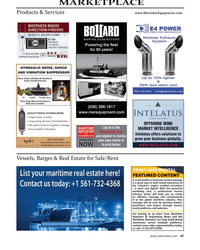 )
April 2024 - Maritime Reporter and Engineering News page: 47
)
April 2024 - Maritime Reporter and Engineering News page: 47MARKETPLACE Products & Services www.MaritimeEquipment.com Powering the fleet for 60 years! HYDRAULIC NOISE, SHOCK AND VIBRATION SUPPRESSOR Noise, Shock, VibraO on & PulsaO on in Quiet, Smooth Flow Out Oil Bladder Nitrogen (blue) Manufactured by MER
-
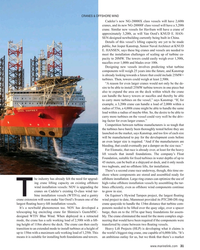 )
April 2024 - Maritime Reporter and Engineering News page: 31
)
April 2024 - Maritime Reporter and Engineering News page: 31CRANES & OFFSHORE WIND Cadeler’s new NG-20000X class vessels will have 2,600t cranes, and its new NG-20000F class vessel will have a 3,200t crane. Similar new vessels for Havfram will have a crane of approximately 3,200t, as will Van Oord’s KNUD E. HAN- SEN-designed newbuilding currently being built in
-
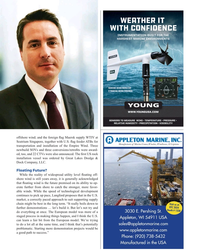 )
April 2024 - Maritime Reporter and Engineering News page: 23
)
April 2024 - Maritime Reporter and Engineering News page: 23offshore wind; and the foreign ? ag Maersk supply WTIV at Seatrium Singapore, together with U.S. ? ag feeder ATBs for transportation and installation of the Empire Wind. Three newbuild SOVs and three conversions/retro? ts were award- ed, too, and 22 CTVs were also announced. The ? rst US rock installa
-
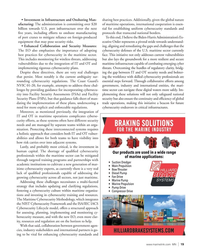 )
April 2024 - Marine News page: 19
)
April 2024 - Marine News page: 19towards U.S. port infrastructure over the next tial for establishing uniform cybersecurity standards and ? ve years, including efforts to onshore manufacturing protocols that transcend national borders. of port cranes to mitigate reliance on foreign-produced To this end, I believe the Biden-Harris Administrat
-
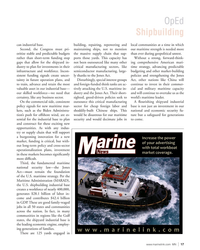 )
April 2024 - Marine News page: 17
)
April 2024 - Marine News page: 17that allow for the shipyard in- not been outsourced like many other ing comprehensive American mari- dustry to plan for investments in their critical manufacturing sectors, like time strategy, advancing predictable infrastructure and workforce. Incon- semiconductor manufacturing, large- budgeting and other
-
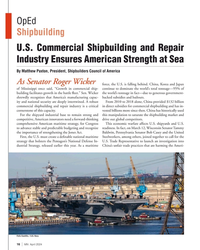 )
April 2024 - Marine News page: 16
)
April 2024 - Marine News page: 16facilitates growth in the battle ? eet.” Sen. Wicker the world’s tonnage in fact—due to generous government- shrewdly recognizes that America’s manufacturing capac- backed subsidies and bailouts. ity and national security are deeply intertwined. A robust From 2010 to 2018 alone, China provided $132
-
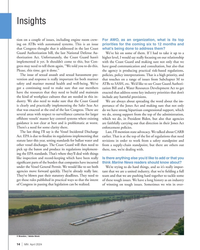 )
April 2024 - Marine News page: 14
)
April 2024 - Marine News page: 14Insights tion on a couple of issues, including engine room crew- For AWO, as an organization, what is its top ing on ATBs with automated systems. This is an issue priorities for the coming six to 12 months and that Congress thought that it addressed in the last Coast what’s being done to address them? Gua
-
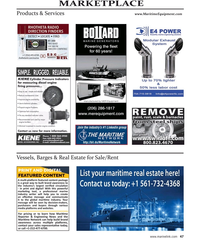 )
February 2024 - Maritime Reporter and Engineering News page: 47
)
February 2024 - Maritime Reporter and Engineering News page: 47MARKETPLACE Products & Services www.MaritimeEquipment.com Powering the fleet for 60 years! Manufactured by MER Equipment (206) 286-1817 www.merequipment.com Join the industry’s #1 Linkedin group http://bit.do/MaritimeNetwork Vessels, Barges & Real Estate
-
 )
February 2024 - Maritime Reporter and Engineering News page: 44
)
February 2024 - Maritime Reporter and Engineering News page: 44Tech Files Latest Products & Technologies MarineShaft Yanmar Hydrogen MarineShaft specializes in urgent re- Fuel Cell AIP pair/replacement of damaged rudder and Yanmar Power Technology Co., Ltd. propeller equipment along with many (Yanmar PT), a subsidiary of Yanmar on-site repair services. MarineShaft
-
 )
February 2024 - Maritime Reporter and Engineering News page: 22
)
February 2024 - Maritime Reporter and Engineering News page: 22locomotive. with more than 27,000 employees, and we have more than 50 Following that, I focused my interest into the area of engine years of engine manufacturing experience, with more than 30,000 performance calibration, emissions and combustion research engines produced across all applications. The maritime
-
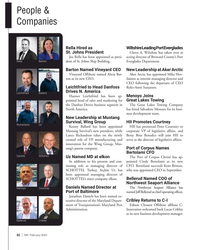 )
February 2024 - Marine News page: 42
)
February 2024 - Marine News page: 42, while corporate VP of legislative affairs, and Lance Richardson takes on the newly Betsy Bina Benedict will join HII to created role of VP manufacturing and serve as the director of legislative affairs. innovation for the Wing Group, Mus- Port of Corpus Names tang’s parent company. Bertolami CFO Daniel
-
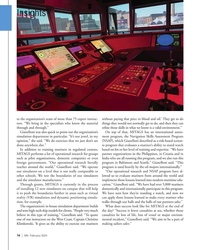 )
February 2024 - Marine News page: 14
)
February 2024 - Marine News page: 14Insights to the organization’s team of more than 75 expert instruc- without paying that price in blood and oil.’ They get to do tors. “We bring in the specialists who know the material things they would not normally get to do, and then they can through and through.” re? ne those skills in what we know
-
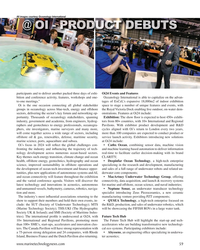 )
January 2024 - Marine Technology Reporter page: 59
)
January 2024 - Marine Technology Reporter page: 59Ocean Technology, a high-tech enterprise science, improved sustainability in offshore operations and specializing in the research and development, manufacturing the development of ocean-tech investment and ? nance oppor- and sales of a full range of underwater robots and related un- tunities, plus new
-
 )
January 2024 - Marine Technology Reporter page: 56
)
January 2024 - Marine Technology Reporter page: 56, Ortega the assembly process to make it scalable and easy to attach. and the Gazelle team are ? rmly planted in the here and now, As in our case, manufacturing different modules that attach to focusing ? rst on the pilot test, plus the most recent news where each other rather than having to produce the
-
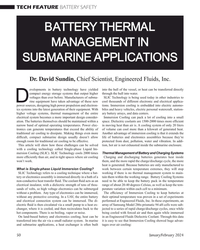 )
January 2024 - Marine Technology Reporter page: 50
)
January 2024 - Marine Technology Reporter page: 50TECH FEATURE BATTERY SAFETY BATTERY THERMAL MANAGEMENT IN SUBMARINE APPLICATIONS Dr. David Sundin, Chief Scientist, Engineered Fluids, Inc. evelopments in battery technology have yielded into the hull of the vessel, or heat can be transferred directly compact energy storage systems that output higher
-
 )
January 2024 - Maritime Reporter and Engineering News page: 40
)
January 2024 - Maritime Reporter and Engineering News page: 40innovative tech- Navy. The EMS will be manufactured in Austal USA’s alu- nologies in the ship design to reduce the CO2 emissions from minum manufacturing line following completion of the last shipping. The primary fuel for the ships will be LNG. Expeditionary Fast Transport (EPF 16). The Expeditionary
-
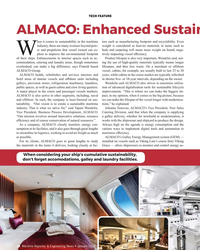 )
January 2024 - Maritime Reporter and Engineering News page: 38
)
January 2024 - Maritime Reporter and Engineering News page: 38TECH FEATURE ALMACO: Enhanced Sustain hen it comes to sustainability in the maritime tors such as manufacturing footprint and recyclability. Even industry, there are many avenues beyond pow- weight is considered as heavier materials in items such as er and propulsion that vessel owned can ex- beds and
-
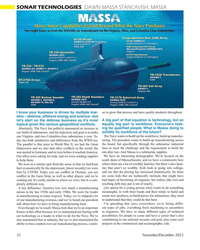 )
November 2023 - Marine Technology Reporter page: 32
)
November 2023 - Marine Technology Reporter page: 32to build up the workforce, build up manufac- day has both similarities and differences from the WWII era. turing. The president wants to build up manufacturing across The parallel is that prior to World War II, we had the Great the board, but speci? cally through the submarine industrial Depression
-
 )
November 2023 - Marine Technology Reporter page: 30
)
November 2023 - Marine Technology Reporter page: 30SONAR TECHNOLOGIES DAWN MASSA STANCAVISH, MASSA GENERATIONS OF INNOVATION IN SONAR & ULTRASONIC TECHNOLOGY Massa Products Corporation designs and manufactures sonar and ultrasonic products for use in ocean, air and ? uids. A long- tenured innovator in the subsea space, Massa is the “eyes and ears
-
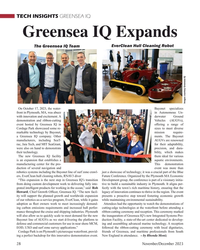 )
November 2023 - Marine Technology Reporter page: 28
)
November 2023 - Marine Technology Reporter page: 28technology. bility, which makes The new Greensea IQ facility them ideal for various is an expansion that establishes a aquatic environments. manufacturing center for the pro- This demonstration duction of several navigation and event was more than robotics systems including the Bayonet line of
-
 )
November 2023 - Marine Technology Reporter page: 14
)
November 2023 - Marine Technology Reporter page: 14organic objects as live ordnance, or, con- sion is of course paramount. A compromised network used versely, classify actual mines as benign. during manufacturing, testing, or maintenance, for example, And cyberattacks don’t necessarily need to involve lines of could enable an adver- code. Kinetic attacks
